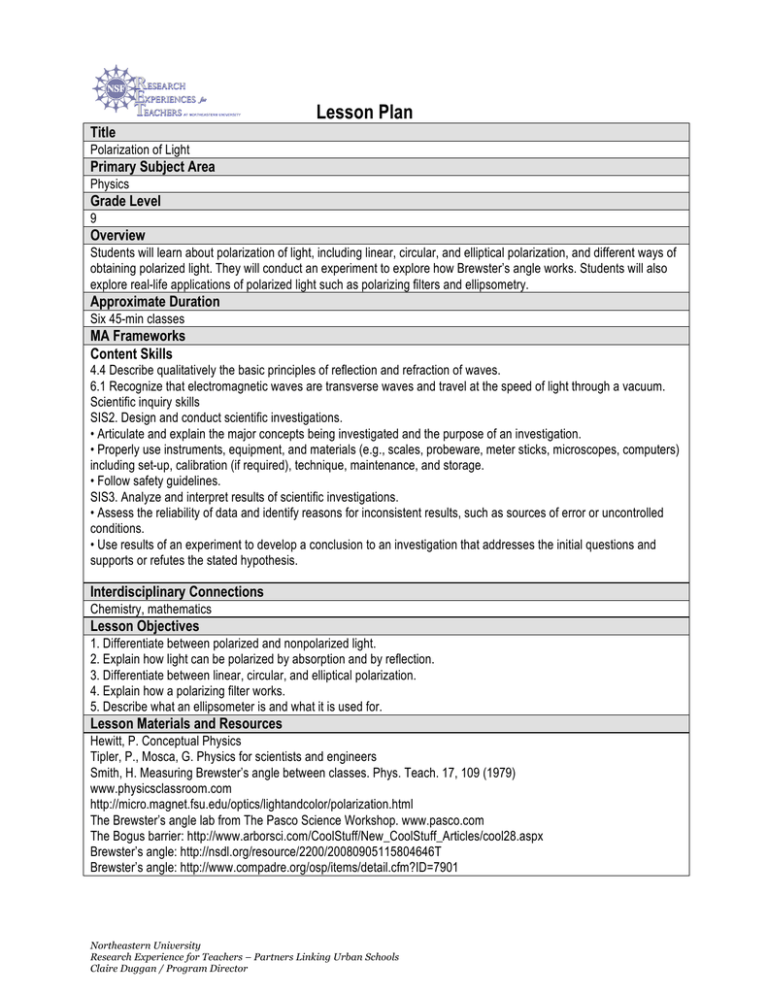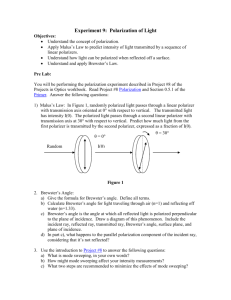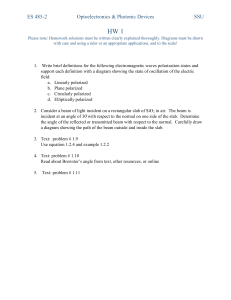Polarization of Light
advertisement

Lesson Plan Title Polarization of Light Primary Subject Area Physics Grade Level 9 Overview Students will learn about polarization of light, including linear, circular, and elliptical polarization, and different ways of obtaining polarized light. They will conduct an experiment to explore how Brewster’s angle works. Students will also explore real-life applications of polarized light such as polarizing filters and ellipsometry. Approximate Duration Six 45-min classes MA Frameworks Content Skills 4.4 Describe qualitatively the basic principles of reflection and refraction of waves. 6.1 Recognize that electromagnetic waves are transverse waves and travel at the speed of light through a vacuum. Scientific inquiry skills SIS2. Design and conduct scientific investigations. • Articulate and explain the major concepts being investigated and the purpose of an investigation. • Properly use instruments, equipment, and materials (e.g., scales, probeware, meter sticks, microscopes, computers) including set-up, calibration (if required), technique, maintenance, and storage. • Follow safety guidelines. SIS3. Analyze and interpret results of scientific investigations. • Assess the reliability of data and identify reasons for inconsistent results, such as sources of error or uncontrolled conditions. • Use results of an experiment to develop a conclusion to an investigation that addresses the initial questions and supports or refutes the stated hypothesis. Interdisciplinary Connections Chemistry, mathematics Lesson Objectives 1. Differentiate between polarized and nonpolarized light. 2. Explain how light can be polarized by absorption and by reflection. 3. Differentiate between linear, circular, and elliptical polarization. 4. Explain how a polarizing filter works. 5. Describe what an ellipsometer is and what it is used for. Lesson Materials and Resources Hewitt, P. Conceptual Physics Tipler, P., Mosca, G. Physics for scientists and engineers Smith, H. Measuring Brewster’s angle between classes. Phys. Teach. 17, 109 (1979) www.physicsclassroom.com http://micro.magnet.fsu.edu/optics/lightandcolor/polarization.html The Brewster’s angle lab from The Pasco Science Workshop. www.pasco.com The Bogus barrier: http://www.arborsci.com/CoolStuff/New_CoolStuff_Articles/cool28.aspx Brewster’s angle: http://nsdl.org/resource/2200/20080905115804646T Brewster’s angle: http://www.compadre.org/osp/items/detail.cfm?ID=7901 Northeastern University Research Experience for Teachers – Partners Linking Urban Schools Claire Duggan / Program Director Technology Tools and Materials Polarizing filters Shoeboxes Computer Pasco: Brewster’s Angle accessory, optics bench, high sensitivity light sensor (2), rotary motion sensor, aperture bracket for light sensor (2), red diode laser, spectrophotometer accessory kit Vernier ULI interface or Pasco interface Logger Pro (or DataStudio) software Background Information Light is an electromagnetic wave that consists of electric and magnetic fields oscillating perpendicular to each other and, at the same time, perpendicular to the direction of propagation of light. Since the electric and magnetic components of an electromagnetic wave are interconnected, it is enough to consider only the electric component. Common light coming from a light bulb or from the Sun contains various waves oscillating in different directions. It is called nonpolarized light. When the electric field of a light wave oscillates in one direction only, the wave is linearly polarized. When the electric field vector traces a circle during its oscillations, the light has circular polarization. When the electric field makes an ellipse, the light is elliptically polarized. Some long-chain hydrocarbon molecules absorb the component of the electric field of incident light that is perpendicular to the chains and transmit the component that is parallel to the chains. Polarizing filters made of such molecules produce linearly polarized light. Consider a nonpolarized light beam shining at a non-conducting (dielectric surface). We can resolve the electric field of the incident light into two components: parallel to the plane of incidence and perpendicular to the plane of incidence. See the picture below (http://www.physics.upenn.edu/courses/gladney/phys151/lectures/lecture_apr_09_2003.shtml) The reflected light mostly contains the perpendicular component of the incident light. At a certain angle of incidence (Brewster’s angle), the reflected light is all linearly polarized perpendicular to the plane of incidence. The value of Brewster’s angle depends on the indices of refraction of the first and the second medium. The polarization effect is used in ellipsometry. Ellipsometry is a method used for determining the thickness of thin films and their optical constants, such as the index of refraction, using polarized light. An ellipsometer sends a beam of linearly polarized light to a sample. The incident beam of light is reflected off the sample and changes its state of polarization during reflection. The change in polarization state is measured and then analyzed by a computer. The obtained information is used to calculate the thickness of the sample and its index of refraction. Useful Vocabulary New Vocabulary Word polarized light polarizer Brewster’s angle ellipsometry Meaning light that consists of electromagnetic waves vibrating in a specific direction a device that changes a beam of nonpolarized light into a polarized light the angle of incidence that makes the reflected beam completely polarized a method of determining the thickness of thin films and their optical constants using polarization of light Northeastern University Research Experience for Teachers – Partners Linking Urban Schools Claire Duggan / Program Director Essential Questions to be answered; Grand Challenges What is the difference between polarized light and nonpolarized light? What is polarized light? How can polarized light be created? How does polarization by reflection work? What is Brewster’s angle? Where do we use polarization in real-life? Misconceptions Light travels as rays in straight lines. Light reflects only from mirrors or objects with polished surface. Lesson Procedures Part 1: Introduction to polarization of light. (45 min) • Pre-lesson homework: Read pages 542- 545 of Conceptual Physics. In your notebook, answer questions 2022 from page 549 • In class: all class discussion (facilitated by the teacher) of the homework. • The bogus barrier activity – students work in pairs. (http://www.arborsci.com/CoolStuff/New_CoolStuff_Articles/cool28.aspx) • Post-lesson homework: read the online tutorial on the Brewster angle (http://nsdl.org/resource/2200/20080905115804646T) Part 2: Brewster’s angle. (45 min) • All class discussion (facilitated by the teacher) of the homework. • Demonstration: http://www.compadre.org/osp/items/detail.cfm?ID=7901 • Activity: Determining Brewster’s angle in the hallway. (See Smith: Measuring Brewster’s angle between classes) • Homework: Read the Brewster’s lab procedure. Part 3. The Brewster’s angle lab. (three 45-min classes) • The purpose of this lab is to measure Brewster’s angle for a light beam reflected off an acrylic semi-circular lens. The intensity of the reflected light is measured by a light sensor. The angle of reflection is measured by a rotary sensor. The Brewster angle is the angle at which the intensity of the reflected light is the lowest. • The experimental set up and calibration are complicated and take a lot of time. Therefore, to save time and make sure that the stations are set up correctly, the lab setup will be performed by a teacher before the lab. • Homework: 1. The Brewster’s angle lab report. 2. Go to www.youtube.com. Search for a movie on ellipsometry or ellipsometer. Pick a movie that you think is the most helpful in understanding what ellipsometry is or how an ellipsometer works. E-mail me the title of the movie. Part 4. Applications of polarized light: ellipsometry. (45 min) • Students will report about the movies on ellipsometry. • We will watch 2-3 movies selected by the students. • Then, I will give a short presentation about my experience of working with the ellipsometer during the RET program at BU. • We will watch the remaining movies. • Homework: Study for the quiz on polarization. Assessment Procedures Observation of students as they work in groups. Homework. Lab report. Quiz on polarization of light. Accommodations/Modifications Visual learners: movies and simulations; white board diagrams Auditory learners: discussions in groups and as a class Reproducible Materials The Bogus barrier activity. Northeastern University Research Experience for Teachers – Partners Linking Urban Schools Claire Duggan / Program Director The Brewster’s angle lab. Explorations and Extensions Research on FTIR: what is FTIR, what it is used for, and what physics concepts are involved. Lesson Development Resources Hewitt, P. Conceptual Physics Tipler, Mosca Physics for scientists and engineers Hastings A. Smith. Measuring Brewster’s angle between classes. Phys. Teach. 17, 109 (1979) www.physicsclassroom.com http://micro.magnet.fsu.edu/optics/lightandcolor/polarization.html The Brewster’s angle lab from The Pasco Science Workshop. www.pasco.com http://www.arborsci.com/CoolStuff/New_CoolStuff_Articles/cool28.aspx http://nsdl.org/resource/2200/20080905115804646T http://www.compadre.org/osp/items/detail.cfm?ID=7901 Reflections Contact Information Valentina Sountsova Bancroft School 110 Shore Drive Worcester, MA vsountsova@bancroftschool.org Northeastern University Research Experience for Teachers – Partners Linking Urban Schools Claire Duggan / Program Director



